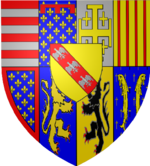LouisPhilippeCharles (talk | contribs) |
m robot Adding: pl:Henri I de Guise |
||
| Line 136: | Line 136: | ||
[[ja:アンリ1世 (ギーズ公)]] |
[[ja:アンリ1世 (ギーズ公)]] |
||
[[no:Henrik, 3. hertug av Guise]] |
[[no:Henrik, 3. hertug av Guise]] |
||
[[pl:Henri I de Guise]] |
|||
[[pt:Henrique I de Guise]] |
[[pt:Henrique I de Guise]] |
||
[[ru:Генрих I де Гиз]] |
[[ru:Генрих I де Гиз]] |
||
Revision as of 07:06, 21 August 2010


Henry I, Prince of Joinville, Duke of Guise, Count of Eu (January 31, 1550 – December 23, 1588, Château de Blois), sometimes called Le Balafré, "the scarred", was the eldest son of Francis, Duke of Guise, and Anna d'Este. His maternal grandparents were Ercole d'Este II, Duke of Ferrara and Renée of France.
Life
He succeeded his father in 1563 as Duke of Guise and Grand Maître de France. He fought the Turks in Hungary in 1565, and on his return, he became one of the leaders of the Catholic faction in the French Wars of Religion. He fought at the Battle of Saint-Denis in 1567, and at Battle of Jarnac and Battle of Moncontour. His courting of Margaret of Valois in 1570 offended her brother, Charles IX of France, but his marriage to Catherine of Cleves restored his fortunes. Considering the Huguenot leader Admiral Coligny the architect of his father's assassination during the siege of Orléans in 1563, he murdered the Admiral in August 1572, thereby setting off the St. Bartholomew's Day Massacre.
Henry was wounded at the Battle of Dormans (October 10, 1575), and was thereafter known, like his father, as "Le Balafré". With a charismatic and brilliant public reputation, he rose to heroic stature among the Catholic population of France as an opponent of the Huguenots.
In 1576 he formed the Catholic League to keep the new heir, the Protestant Henry of Navarre, off the throne. The talent and dash of Guise contrasted favorably with the vacillation and weakness of Henry III. He was said to have claimed a Carolingian descent and cast eyes on the throne. This led to the stage of the Wars of Religion known as the War of the Three Henries (1584-1588).
However, at the death in 1584 of Francis, Duke of Anjou, the king's brother (which left Henry of Navarre, the Protestant champion, as heir-male), Guise concluded the Treaty of Joinville with Philip II of Spain. This compact declared that the Cardinal de Bourbon should succeed Henry III, in preference to Henry of Navarre. Henry III now sided with the Catholic League (1585), which made war with great success on the Protestants. Guise sent his cousin Charles, Duke of Aumale to lead a rising in Picardy (which could also support the retreat of the Spanish Armada). Alarmed, Henry III ordered Guise to remain in Champagne; he defied the king and on May 9, 1588 Guise entered Paris, bringing to a head his ambiguous challenge to royal authority in the Day of the Barricades and forcing King Henry to flee.
The League now controlled France; the king was forced to accede to its demands and created Guise Lieutenant-General of France. But Henry III refused to be treated as a mere cipher by the League, and decided upon a bold stroke. On December 23, 1588, at the Château de Blois, Guise was summoned to attend the king, and was at once assassinated. His brother Louis II, Cardinal of Guise was assassinated by "the Forty-five", the king's bodyguard, the next day. The deed aroused such outrage among the remaining relatives and allies of Guise that Henry III was forced to take refuge with Henry of Navarre. (Henry III was assassinated the next year by Jacques Clément, an agent of the Catholic League).
In popular culture
The Duc de Guise appears as an archetypal Machiavellian schemer in Christopher Marlowe's The Massacre at Paris, which was written a few years after the St. Bartholomew's Day massacre.
L'Assassinat du Duc de Guise, Op. 128, first shown at the Salle Charras in Paris on 16 November 1908, was the first film to include a score written by a well-known classical composer Camille Saint-Saëns.
Ancestors
| Family of Henry I, Duke of Guise | ||||||||||||||||||||||||||||||||||||||||||||||||||||||||||||||||||||||||||||||||||||||||||||||||||||||||||||||||||||||||||||||||||||||||||||||||||||||||||||||||||||||||||||||||||||||||||||||||||||||||||||||||||||||||||||||||||||||||||||||||||||||||||||||||||||||||||||||||||||||||||||||||||||||||||||||||||||||||||||||||||||||||||||||||||||||||||||||||||||||||||||||||||||||||||||||||||||||||||||||||||||||||||||||||||||||||||||||||||||||||||||||||||||||||||||||||||||||||||||||||||||||||||||||||||||||||||||||||||||||||||||||||||||||||||||||||||||||||||||||||||||||||||||||||||||||||||||||||
|---|---|---|---|---|---|---|---|---|---|---|---|---|---|---|---|---|---|---|---|---|---|---|---|---|---|---|---|---|---|---|---|---|---|---|---|---|---|---|---|---|---|---|---|---|---|---|---|---|---|---|---|---|---|---|---|---|---|---|---|---|---|---|---|---|---|---|---|---|---|---|---|---|---|---|---|---|---|---|---|---|---|---|---|---|---|---|---|---|---|---|---|---|---|---|---|---|---|---|---|---|---|---|---|---|---|---|---|---|---|---|---|---|---|---|---|---|---|---|---|---|---|---|---|---|---|---|---|---|---|---|---|---|---|---|---|---|---|---|---|---|---|---|---|---|---|---|---|---|---|---|---|---|---|---|---|---|---|---|---|---|---|---|---|---|---|---|---|---|---|---|---|---|---|---|---|---|---|---|---|---|---|---|---|---|---|---|---|---|---|---|---|---|---|---|---|---|---|---|---|---|---|---|---|---|---|---|---|---|---|---|---|---|---|---|---|---|---|---|---|---|---|---|---|---|---|---|---|---|---|---|---|---|---|---|---|---|---|---|---|---|---|---|---|---|---|---|---|---|---|---|---|---|---|---|---|---|---|---|---|---|---|---|---|---|---|---|---|---|---|---|---|---|---|---|---|---|---|---|---|---|---|---|---|---|---|---|---|---|---|---|---|---|---|---|---|---|---|---|---|---|---|---|---|---|---|---|---|---|---|---|---|---|---|---|---|---|---|---|---|---|---|---|---|---|---|---|---|---|---|---|---|---|---|---|---|---|---|---|---|---|---|---|---|---|---|---|---|---|---|---|---|---|---|---|---|---|---|---|---|---|---|---|---|---|---|---|---|---|---|---|---|---|---|---|---|---|---|---|---|---|---|---|---|---|---|---|---|---|---|---|---|---|---|---|---|---|---|---|---|---|---|---|---|---|---|---|---|---|---|---|---|---|---|---|---|---|---|---|---|---|---|---|---|---|---|---|---|---|---|---|---|---|---|---|---|---|---|---|---|---|---|---|---|---|---|---|---|---|---|---|---|---|---|---|---|---|---|---|---|---|---|---|---|---|---|---|---|---|---|---|---|---|---|---|---|---|---|---|---|---|---|---|---|---|---|---|---|---|---|---|---|---|---|---|---|---|---|---|---|---|---|---|---|---|---|---|---|---|---|---|---|---|---|---|---|---|---|---|---|---|---|---|---|---|---|---|---|---|---|---|---|---|---|---|---|---|---|---|---|---|---|---|---|---|---|---|---|---|---|---|---|---|---|---|---|---|---|---|---|---|---|---|---|---|---|---|---|---|---|---|---|---|---|---|---|---|---|---|---|---|---|---|---|---|---|---|---|---|---|---|---|---|
| ||||||||||||||||||||||||||||||||||||||||||||||||||||||||||||||||||||||||||||||||||||||||||||||||||||||||||||||||||||||||||||||||||||||||||||||||||||||||||||||||||||||||||||||||||||||||||||||||||||||||||||||||||||||||||||||||||||||||||||||||||||||||||||||||||||||||||||||||||||||||||||||||||||||||||||||||||||||||||||||||||||||||||||||||||||||||||||||||||||||||||||||||||||||||||||||||||||||||||||||||||||||||||||||||||||||||||||||||||||||||||||||||||||||||||||||||||||||||||||||||||||||||||||||||||||||||||||||||||||||||||||||||||||||||||||||||||||||||||||||||||||||||||||||||||||||||||||||||
Issue
He married on October 4, 1570 in Paris to Catherine of Cleves (1548–1633), Countess of Eu, by whom he had fourteen children:
- Charles, Duke of Guise (1571–1640), who succeeded him
- Henri (June 30, 1572, Paris – August 13, 1574)
- Louis III, Cardinal of Guise (1575–1621), Archbishop of Reims
- Charles (January 1, 1576, Paris) (died at birth)
- Claude, Duke of Chevreuse (1578–1657) married Marie de Rohan, daughter of Hercule de Rohan, duc de Montbazon
- François (May 14, 1581 – September 29, 1582)
- François Alexandre (February 7, 1589 – June 1, 1614, Château des Baux), a Knight of the Order of Malta
- Catherine (November 3, 1573) (died at birth)
- Marie (June 1, 1577 – 1582)
- Catherine (b. May 29, 1579), d. young
- Christine (January 21, 1580) (died at birth)
- Renée (1585 – June 13, 1626, Reims), Abbess of St. Pierre
- Jeanne (July 31, 1586 – October 8, 1638, Jouarre), Abbess of Jouarre
- Louise Marguerite, (1588 – April 30, 1631, Château d'Eu), married at the Château de Meudon on July 24, 1605 François, Prince of Conti
Literature
- Pierre Matthieu , La Guisiade (1589).
- Christopher Marlowe, The Massacre at Paris (1593).
- George Chapman, The Tragedy of Bussy D'Ambois (1607).
- George Chapman, The Revenge of Bussy D'Ambois (1613).
- John Dryden & Nathaniel Lee, The Duke of Guise (1683).